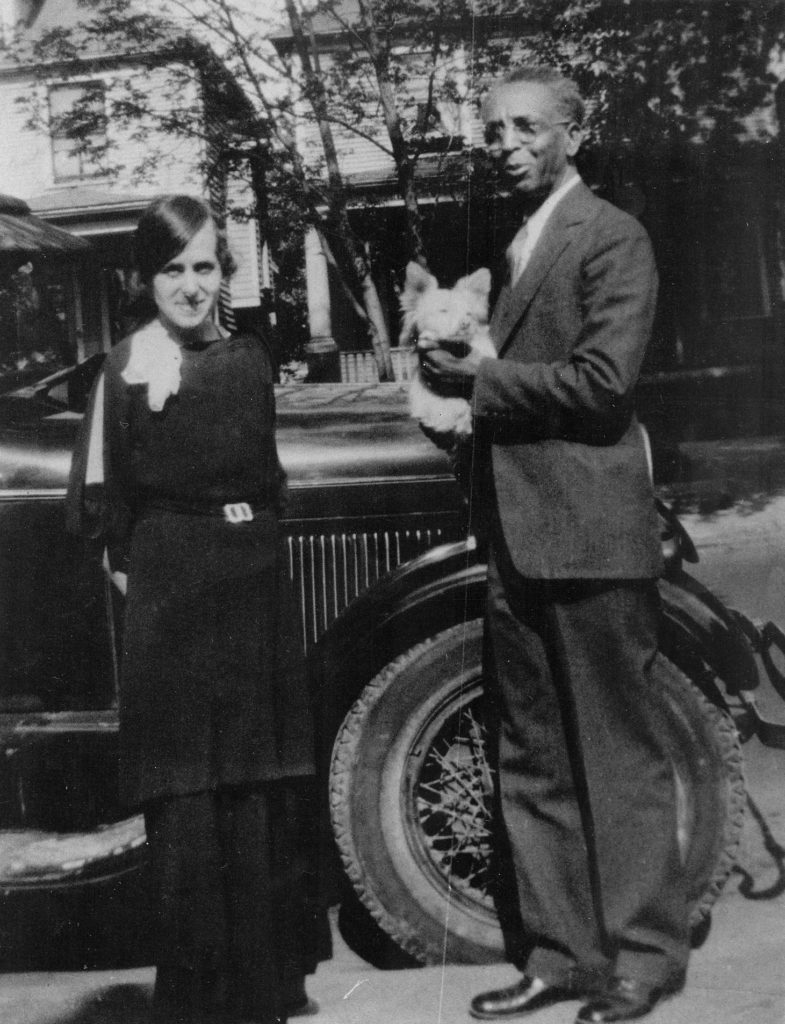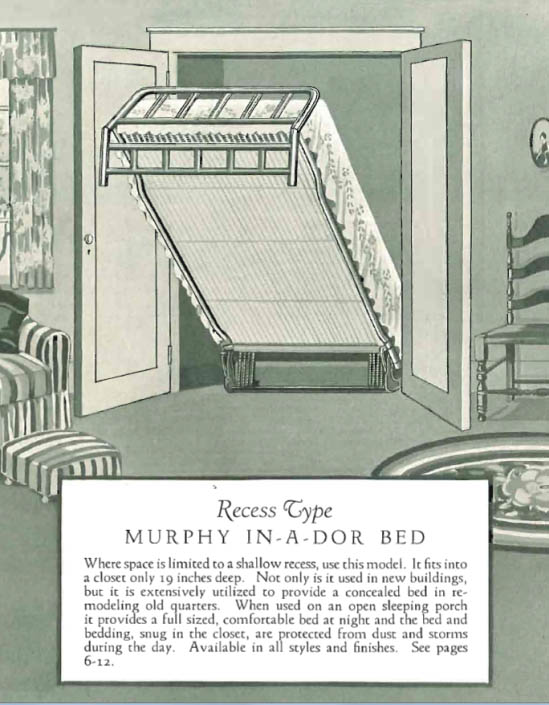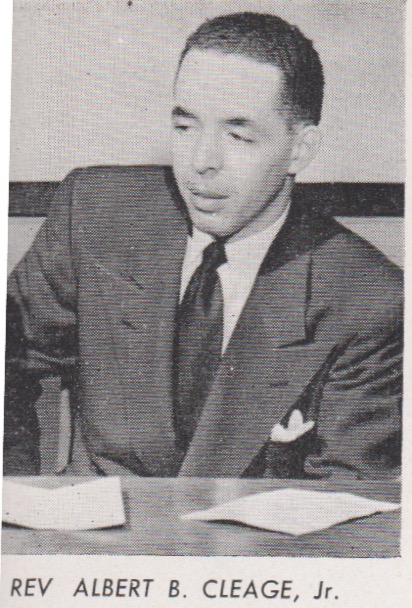Category Archives: Cleages
Dr. & Mrs. Cleage Speak On Preventing Juvenile Delinquency
In an article in The Detroit Tribune issue of February 26, 1938, my grandmother, Mrs. Pearl Reed Cleage was announced as the speaker for the next meeting of the West Side Human Relation Council on the following Monday. I looked in The Detroit Tribune that came out the following week and there was nothing about that meeting or my grandmother’s speech, but I found an article that mentioned a speech on the same topic of juvenile delinquency that my grandfather had made the previous month. Both articles are below.
You can find more information about the Cleage family during this time in this post The Cleage’s in the 1940 Census.
West Side Human Relation Council Looks to Mothers
The West Side Human Relation Council met Monday at the Lothrop branch library, West Grand Boulevard at Warren avenue. Turner W. Ross, president, presided.
Reports from the various committees were made and accepted by the council. A discussion concerning the toy-making project now under way followed. Another suggestion for discussion was the consideration for the organization of a group composed of mothers. It was the belief of the council members that the mothers could contribute much in the fight against juvenile deliquency. John C. Dancy, executive secretary of the Detroit Urban League, spoke regarding a west side community center.
The next meeting of the council will be Monday at the same place. Mrs. Albert Cleage is scheduled to discuss “Good Home Environment as a Potent Factor in Delinquency.”
___________________

Cleage Talks on Children
Speaks at Juvenile Group Meeting
The January meeting of the Juvenile Protective Association of Michigan was largely attended by members and visitors.
The membership campaign under the supervision of Mrs. Gertrude Henderson assisted by Mrs. Mamye Donovan and Mrs. John O’Dell, have made visits to various churches, taking the program and purpose of the organization to the people. Many pledged their support.
The guest speaker at the last meeting was Dr. A. B. Cleage, a member of the organization, also a staff member at the Receiving Hospital. Dr. Cleage gave a very interesting talk on the need of the home and nurseries for children of the race. He spoke of cases where children who had no home guidance or training, fall easy victims to disease of body and mind.
The next meeting will be held Monday, March 7 at 7:30 p.m. at the home of Mr. and Mrs. John O’Dell. The speaker will be Attorney Charles Roxborough.
Luther C. Keith is president.

Dialogue in Poetry
Louis Cleage Responds Poetically to “Two Songs” by Gary Grimshaw
During the 1960s, my uncles owned and operated Cleage Printers. It was what was known as a “job printer,” meaning that it didn’t print books, but rather printed handbills for neighborhood markets and flyers, newsletters, magazines and pamphlets for various radical groups, including the black nationalist Group on Advanced Leadership (GOAL), the Trotskyist Socialist Workers Party (SWP) and the Detroit Artists Workshop, a countercultural collaborative.
The printing plant was a place where people came to find discussion of the issues of the day and there were plenty of issues to discuss. My uncle Henry loved to hold forth on a variety of topics and his arguments were always well thought out and convincing. Hugh didn’t talk a lot, but he would have something to put in, maybe just a quiet shake of his head over what Henry was saying.
Their brother Louis Cleage was a doctor and his office was about 10 feet in front of the printing plant. When he came back, he would join in with his sarcastic comments and distinctive laugh. And surprising to me, my uncle Louis wrote poetry.
On Oct. 6, 2019, my good friend historian Paul Lee, who likes to consider himself an “honorary Cleage,” sent me an email with a copy of a poem that my uncle Louis had written.
I was so surprised because with all of Louis’ talents, I never knew that he wrote poetry. I immediately began to search for the poems that he was responding to, which were written by Detroit graphic artist and radical political activist Gary Grimshaw.
After Googling and looking for Work 4, where Grimshaw’s poems appeared, I found that the Flickr photostream of “jwc 3o2” (Canadian “cultural factotum” jw curry) had a copy of the cover (designed by Grimshaw) and wrote to ask him if he had the whole work and could send me a copy of the poems. He very kindly dug out his copy of Work 4, made a copy of the poems and sent them to me. You can see the cover and the poems by both Grimshaw and Louis below.

Two Songs by Gary Grimshaw
You’ve made your responsibilities
To wash your car and mow your lawn
While I’ve made mine
To stay excited about being alive
And you don’t understand
Why I won’t stay home
Without seeing it happen
You’ve slipped into the norm
While I’ve kept my eyes open
For the pleasure of new things
And you don’t understand
Why I am different from the rest
In the name of reason
You’ve drained the joy from life
While I make mistakes
Because I won’t listen to advice
From a dying generation
And you wonder why
I stare at the floor when you speak
August 2
“Prove yourself!” yells the Queen of Morality
In her castle on the hill of broken dreams
“But there’s nothing to prove!” I yell back
From my midnight ancient cellar
As the King slips off to the prison factory.
The Queen’s daughters know the virtue of work
They dream of an effortless struggle
Against inactivity and doubt
Carried on in calm organization
Won by merciless repression.
The King once was young, like me
I often think of him this way
Before he volunteered to die
His funeral went unnoticed
In the steady hum of the factory
Where he surrendered to Chief Reason
And succeeding days drove out whim and fancy
Leaving him with What Is and nothing more
What Is, the terrible master.
August 12


A Comment on “Two Songs by Gary Grimshaw“
I heard your song, my son
so clear and yet so lonely in the night.
The enchantment of its melancholy beauty
Transported me through space and time
to moon-lit waters of a blue lagoon.
In the quiet of the night, a golden maiden
played a dulcimer. A nightingale
sang a song of youth and beauty
that stirred my senses with such violence
as to test the very sinews
that bound me to my reason.
I was once again the young King in the timeless land.
The golden maiden was my queen.
Though now, we are as strangers when we meet,
I understand that you are different from the rest.
In the quiet of the night, when the beauty
of your song stirs my heart,
My lonely soul cries out to you, my son,
—-for understanding.
Louis J. Cleage, M.D.
Detroit 3/27/67

_______________________
Header photograph is of the Cleage Clinic (front brick building) with Cleage Printers (gray cement block building) in the back. I photoshopped it from a Google Maps view from July 2009.
I would like to thank Paul Lee for the additional information that he sent me, which I have incorporated into this post.
Click these links for more information:
Cleage Printers
Gary Grimshaw
Louis Cleage

Well, we is in Los Angeles…
Hi Folks:
Well we is in Los Angeles… (Typewriter is still on the way) Our last two weeks in San Francisco were a conglomeration of everybody sending us on our way. We had supper out almost everyday — and all of San Francisco’s Elite entertained us — quite a time was had by all. We also received several gifts in addition to the church’s gift of books — Cigarettes — Candy — towel set — 2 lbs of coffee — ash trays — and books (even a copy of Strange Fruit). People were very nice — with their regrets and hopes that we will return when Thurman leaves. Frisky kept smiling even though it seemed to hurt his face.
Just before we we left we met Rev. Roy Nichols who has another inter-racial church (Congregational) across the Bay in Berkley. His co-pastor is Rev. Gallager who was president of Talladega College before coming to the “Pacific School of Religion”. Nichols “offered me a job “working with him and Gallager — and tried to arrange a meeting with Gallager but I was too busy. (I’m tired of inter-racial churches for the present!)
President Imes of Knoxville College sent me an application blank which I returned (with a letter in which I re-organized Knoxville’s curriculum around religious education!) He said he had an opening for a Prof. of Religious Ed — and a college Preacher — the combined job paying $1,890 per year and house.
(The top corner of the page, where the return address would be on the reverse side is torn out, leaving four half sentences.
….ply to my application …happy to have …ine training and …Knoxville faulty – but he would have to work slowly to get the Elders of the church – and he does not want to seem to be forcing – the issue etc. He also admitted that the salary is very inadequate (with which I agree!!!) He said that he had mentioned my application to the President of Virginia State College who also is looking for a College Preacher but just for a year while the regular preacher is away studying. He suggested that Virginia State will contact me — giving me the opportunity to pick the position which offers the best position. (Nice, isn’t he!)

Anyway – I’m writing Imes and advising him to take his time — I’d rather stay here until next fall anyway I can finish two years work at the U. of Southern California by that time. As I told him, I’m looking for a permanent position which will still allow me time for study during the summer — with an occasional semester off for study etc. I don’t suppose anything will come of it!
Los Angeles is a fine town! Except for our present financial uproar we like it better than any place we’ve been yet.
Our financial-uproar is due to the fact that we have not as yet received our last — $200 — pay! Dr. Smith stopped payment because I insisted upon $200 instead of $135 –. So — I have turned a bill into the church for the balance of $65 due. I suppose I’ll get it all one of these days! (over Frisky’s dead body!)
Our apartment is Super-duper!!! It’s “on the hill”– which in Detroit would be the “North-End” — except its more like Boston Blvd — or Lake-shore Drive!!! — Big — fine houses, lawns and palm-trees. Negroes have not broken into the “hill district” A Mrs. Hammonds of Detroit owns the building (Husband a racketeer (?) or something in Detroit). Our living room is right out of “House and Garden” magazine — It is long with blue wall to wall carpet — and white walls and woodwork — and white walls and colored upholstered furniture — end tables — cocktail table ‘n that — (Ohhh yes and Venetian Blinds at the windows which are all the way across one end of the room with wine-colored drapes at either end!) The bathroom is pale-blue tile with white woodwork ‘n that. Shower — built in bath tub ‘n’ that!
The only catch is the kitchen which is an alcove between the living room and the bah-room. It’s shrewd, too but it ain’t got neither sink nor stove! We’re supposed to get an electric plate to cook on — and the land lady is supposed to put in a sink! The ice-box and cupboard are in. It was called a Bachelor-apt. — and so had no stove or sink.
Both the kitchen living room and bath have built in automatic heating units (gas). The living-room has an “In-a-door-bed” which is very nice — and the closet for clothes! We also have a garage for storage, the building is new and shrewd! Thousands of Negroes within walking distance and all in nice homes – quiet and taken care of just like white-folks. I can see why Daddy wanted to move out here. It would be a fine place to live if you had money!
We’ve been here eating at the restaurant ever since we got here – There’s a very nice little colored restaurant within walking distance “The Faun” – very elite — ‘n’ that! But our pocket-books won’t stand much more of it, — fun though while it lasts!!!
I registered at the University of Southern California today. Its a fine campus and buildings — I can’t tell about classes yet. With the religion fellowship — my bill was $73.00 for 16 hours (full semester). Without the reduction it would have been over $200.00 (and I’d a been right home!) Most (all but one) of my courses are in Cinema — with one religion course to enable me to register in the graduate school of religion.
Doris starts job-hunting any day now! She has an appointment with the Red-Cross and the Urban League. Can’t tell how everything is going to turn out — quite an escapade however, if we can just last a year! and then move on to New York – authorities in the field of Cinema and Religious Ed. ‘n’ that.
Tell the Junior Doctor to keep his fingers crossed until we wire him for money — and then to wire the money — and send “the I told you so” on by air-mail!
Well so-long

Other Letters Home
My Parents Time in San Francisco January to July 1944
Its Friday afternoon August 18, 1944
I have a little problem in “Design” December 20, 1944
Christmas Day 1944 – Part 1
Christmas Day 1944 – Part 2
Christmas Day 1944 – Part 3
Guess we must be writing too much.. January 6, 1945
Thanks for the Springfield information January 13, 1945
We received your letters…March 3, 1945
The Missing Months – March to November 1945

Just a short note…

June 11, 1944
Dear Folks,
Just a short not to tell you-all that we have our Los Angeles address and that the apartment is at least partially furnished. We received a Special from Mr Woodard, the agent who has been looking for a place for us, and this is what he said about the apartment he has for us.
“It is a modern apartment in every detail and is equipped with a living-room suite, carpet, Venetian blinds, and a pull-out bed in the living-room. Adjoining the living-room is a small alcove which is used as a kichenette. It has a frigidaire (I can hardly wait!!) in it but does not have a stove. Adjoining this kitchenette alcove, is a complete tile bath.” The rent is $37.50 per month.
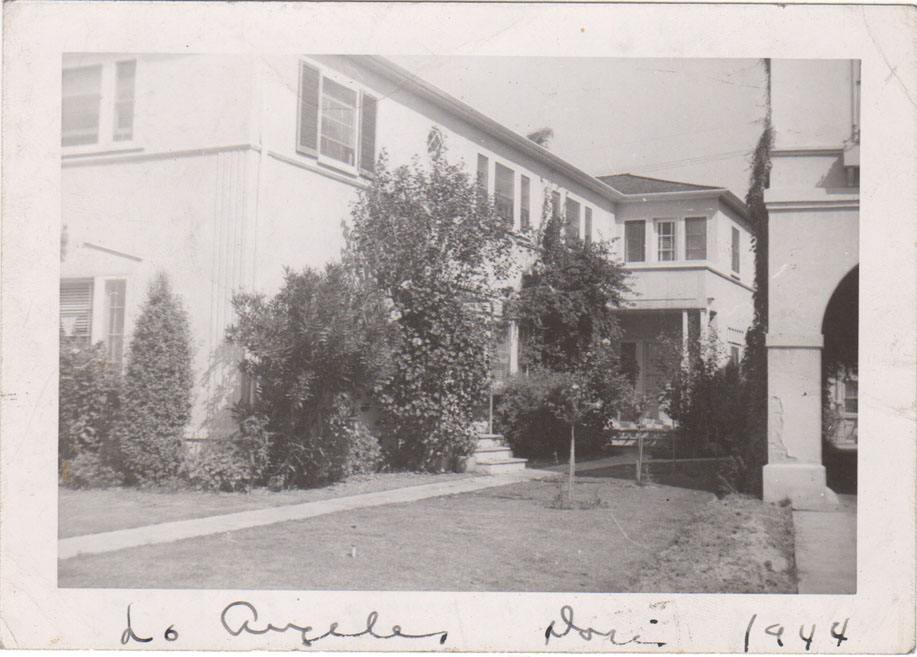
So ——it looks like we will go to Los Angeles and stay awhile. I hope the apartment is as good as he makes it sound. We are very lucky to have a furnished one…. it will save us quite a bit of expense. We have our tickets for July 2 and will leave at 8:15 a.m. and arrive at 6 p.m. the same day. The apartment will be ready for us when we get there, so we will not have to spend money for a hotel room. I am getting all ready to pack. Freight rate from here to L.A. is 90¢ a hundred pounds and if we ship our things four or five days before we leave, they should get there when we do.
Everything here goes well. We went down to Palo Alto yesterday with the Brittons and had a very good time. It was cold and foggy in San Francisco, but down there the sun was shining and we felt the first hot weather we’ve seen since last summer! Stanford University campus was a very interesting place to see what white-folks money can do. Five thousand acres of palm trees, huge stone buildings, carillons, a 30-room house for the President of the University, and an estate for Herbert Hoover… a mess.
Don’t worry about us if our letters are short for awhile. We’ll be busy getting ready to go. We’ll write something every week, though. It takes about six days for your letters (not air-mail —three days for them) to reach us, so if you mail any after June 25, send them to 2130 South Hobart Boulevard, Apartment 4, Los Angeles.
Doris
Hi Folks:
Looks like the “fabulous” Cleages are off on another “fantastic” adventure or something. WE’D VERY MUCH LIKE TO BORROW HENRY’S ELECTRIC-STOVE if you-all aren’t using it (or planning to use it soon.) It’s about the only thing we’ll have to buy for the apartment … except a desk (or table) for me. IF you-all can see your way clear send it to us at the address above RAILWAY EXPRESS right away SO IT WILL BE THERE WHEN WE ARRIVE. and (O.K. LOUIS) send us the bill (for carting and shipping)
I don’t remember whether I mentioned this or not. I heard from the Detroit Council of Churches a few days ago…saying that my application will be placed on file until they raise the money… and promising to contact me this FALL when the plans are worked out a little more definitely.
Don’t worry too much about our Los Angeles expedition… if it doesn’t work out WE’LL BE ALONG HOME ANY DAY. Seems like it might work if the good Lord decides to keep Albert B. Cleage, 3rd in heaven for a couple more years … and Doris can find an EASY job (which is the only sort she’d keep!)
Everything here is just too sweet … the church is arranging a farewell party … and getting a present etc. I preach my last sermon here next Sunday. We had a fine trip yesterday … down to Palo Alto … SOUTH …warm and everything … (Like Los Angeles). A lady in the church has a FORD she wants to sell for $250.00 … I’m trying to talk Doris out of getting it … (since it would leave us too close to broke!) (You can see she sure is a STA-BAL-IZING INFLUENCE! DON’T FORGET THE STOVE! Let us know, either way as soon as possible so we can try to pick up something here if you’re using it!
Toddy
_______________________
Other Letters Home
My Parents Time in San Francisco January to July 1944
Its Friday afternoon August 18, 1944
I have a little problem in “Design” December 20, 1944
Christmas Day 1944 – Part 1
Christmas Day 1944 – Part 2
Christmas Day 1944 – Part 3
Guess we must be writing too much.. January 6, 1945
Thanks for the Springfield information January 13, 1945
We received your letters…March 3, 1945
The Missing Months – March to November 1945
Fellowship Church – Adventure in Interracial Understanding
After leaving Chandler Memorial Church in Lexington in January of 1944, my parents traveled across county, by train to San Francisco, CA where my father, Rev. Albert B. Cleage, Jr. became co-pastor of the interracial Fellowship Church. Here is an article he wrote in October, 1946, about the experience after he had moved on to St. John’s Congregational Church in Springfield, MA. At the end of the transcription, there are links to other posts about the time in San Francisco.

San Francisco’s interracial Fellowship Church is now approaching the close of its first year of existence. Having weathered the storm of birth, infancy and growth, it is now, firmly established with two of America’s outstanding preachers, an expanding community program and a growing congregation.
From the beginning Fellowship Church has tried to de-emphasize its interracial character, preferring to be known as a community church, incidentally interracial. In spite of this theoretical distinction, however, Fellowship Church is nationally known as “San Francisco’s Interracial Church.” The church achieved national attention with the coming of Dr. Howard Thurman and his wife Sue Bailey Thurman.
Time magazine reporter sent to investigate the “project to which Dr. Thurman was coming” explained his interest by stating, “Anything which can drag Dr. Thurman across country for a year must be important.”
Mrs. Franklin D. Roosevelt and Dr. Mordecai Johnson spoke at the testimonial meeting of church notables who gathered to wish Dr. and Mrs. Thurman God-speed on their great Christian adventure. Dr. Thurman spoke of Fellowship Church as “the most significant single step that institutional Christianity is taking in the direction of a really new order for America.”

I arrived at Fellowship Church a few weeks after its organization. All I knew of the project I had gleaned from the letters of Dr. Alfred Fisk, its organizer. He wrote: “We are organizing in San Francisco an interracial church to be known as ‘Fellowship Church.’
We do not want a church run by whites ‘for’ Negroes or one in which Negroes will merely be welcome to participate. We want to establish a church which will be of and by and for both groups. We are planning to have as co-pastors, with absolute equality of status, a Negro and a white person. The boards of the church, the choir, the Sunday School and its staff will be made up of both groups, and perhaps some Filipinos and others.”
I found the Church located in a very old residential neighborhood formerly occupied by the Japanese, but now termed the “Negro District.” Negroes made up about 50 percent of the population. Twenty thousand Negroes were crowded into make-shift rooming houses and apartment houses which had accommodated about eight thousand Japanese.
The city was suffering from a bad case of riot-jitters. Everywhere people seemed to be waiting for the signal which was to begin the fire-works. Both Negroes and whites were frightened and angry in the presence of something they couldn’t understand. D. Fisk, Fellowship Church’s white co-pastor, wrote to Dr. Thurman, “Unless you come to San Francisco we perish!”
San Francisco didn’t like the “new Negro.” They didn’t like his independence, his war-boom pay-checks, and most of all they didn’t like his increasing numbers. Very trivial things loomed large in their discussions of the “problem”, “the way Negroes crowded onto the streetcars to get home from work” “the way Negro women entered the most exclusive shops in their work clothes.”
Miss Vanita Lewis of the Children’s Bureau visited the city to oil the troubled waters. She lectured Negro leaders on the “disciplines of interracial living.”
Policeman were being taught “sociology” by a rabid Negro and Jew hating priest who lectured at great length on the innate racial differences “about which we can do nothing.”
In the midst of this bedlam I found Fellowship Church with 30 members and an infinity of good intentions. Dr. Fisk stated the problem well, “The challenge to a church in such a community is obvious. If ever the spirit of Christ were needed it is here. To interpret that spirit as an effective force in the community is our task as we see it.”
For the first six months of its existence Fellowship Church functioned without any formal membership. All persons who believed in the fellowship-idea were welcome.
The nucleus of the congregation consisted of a group from the American Friend’s Service Center which had been meeting for some months as the core group (The Committee On Racial Equality). They were mature and sincere young people of both races interested in the ideal of human brotherhood. They earnestly worked to build this ideal into a militant active church program. They brought a freshness of spirit and a sincerity of conviction which made of Fellowship something more than just another church, and which alone carried the experiment through the first trying months. Without them there could have been no Fellowship Church.
To this vital nucleus other individuals were attracted. The Negro residents of the immediate community did not overfill the small auditorium as Dr. Fisk had apparently expected. As the congregation steadily grew, attendance remained almost evenly divided between Negroes and whites.
Fellowship Church, as any interracial venture, in the midst of the American community, faced the task of deciding just how far it wanted to go in its undertaking. Each individual faxed the painful responsibility for his personal decision regarding the implications of his commitment to brotherhood and racial equality.
My months at Fellowship Church were devoted to hammering at one basic weakness. I saw clearly that the effectiveness and future of the church depended upon the building of a common social philosophy. People cannot work together to accomplish any program, however small, unless they agree in their interpretations of the total world in which they live.
A group of people cannot attack the “Negro-problem” unless they understand the socioeconomic framework out of which it has grown and upon which it depends. Only then can they decide whether or not they are willing to come to grips with the problem.
At the close of its first year Fellowship Church faces the crucial problem of undergirding its complete program with a common social philosophy. Its future development depends absolutely upon this decision. In this dilemma, of course, Fellowship Church is not alone. Liberal Christians everywhere cannot longer avoid their total responsibility to society by making pleasant and ineffective gestures in restricted and isolated areas of living.
To do something about the Negro problem implies also doing something about the Jewish problem, the Indian Problem, the African Problem, the Labor Problem, the Mexican, Chinese and Japanese Problems.
A Christian church must be even more thank a place where Negroes and whites can worship God together, or it will inevitably become less. It must function in every area of life as a united liberal force striking fearlessly out against all forms of oppression, bigotry and inequality. Its friends are the friends of human freedom no matter what the banner beneath which they march, and its foes are the oppressors of mankind, even though they march beneath the banner of Christ.
________________
My Parents Time in San Francisco
Newspaper Clipping of My Parents in San Francisco 1944
Hanging Up Laundry
My Parent’s Time in Lexington, Kentucky – 1943
This post covers the time from my father’s ordination, my parent’s marriage and the few months they spent in Lexington, Kentucky at Chandler Memorial Church. Click the link to learn more about the history of Chandler.
The news items below were transcribed from The Detroit Tribune (Detroit) and Colored Notes, The Sunday Herald-Leader (Lexington, Kentucky). Click the photographs to enlarge or to go to the websites where I found them.
__________________
Thursday February 4, 1943
Albert B. Cleage ordained at Plymouth Congregational Church, Detroit, Michigan, by Rev. Horace White.
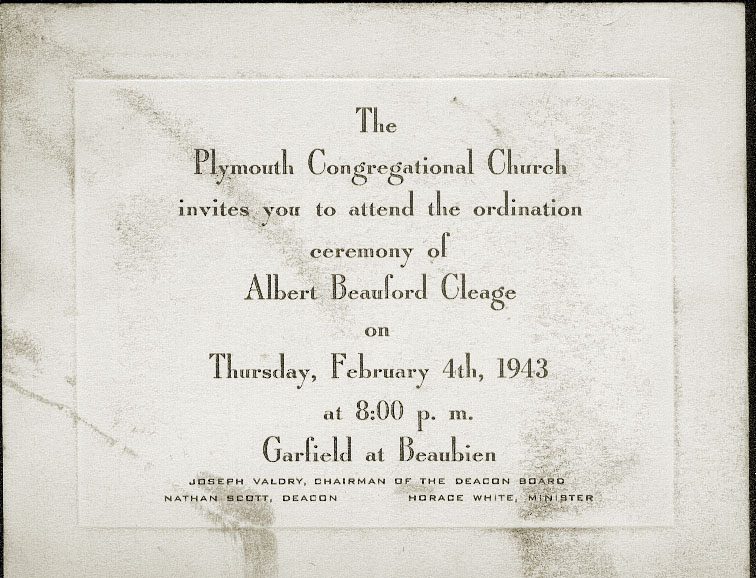


October 2, 1943
Rev. Albert B. Cleage of Detroit, Mich., will preach at the Chandler Memorial church at 11 o’clock Sunday morning.
Sunday, Nov. 7, 1943
Chandler Memorial church worship and sermon, 11 a. m., preaching by the Rev. A. Rice, Sunday school 12:15; Y. P. meeting at 6 p. m. The annual “harvest-home” ingathering will be held Nov. 21-22 Donations may be forwarded, or call 1356-X. Roger Stewart chairman. The new pastor, the Rev. A. B. Cleage will take charge Nov. 21.
November 14, 1943
Chandler Memorial church, worship and sermon, 11 a. m., preaching by the Rev. A. Rice. Sunday school 12:15. Special program at 3:30 p. m., sponsored by Mrs. Louise Newman. Participants are Prof. W. T. Seals, Miss Hattie Lee, L. D. Mills, William Smith and Prof. W. J. Black. The annual “harvest home” ingathering will be held No. 21-22. Donation may be forwarded or call 1356-X. Roger Stewart, chairman. The new pastor, the Rev. A. B. Cleage of Detroit will take charge next Sunday.

These young people composed the bridal party of the Graham-Cleage wedding at Plymouth Congregational Church Wednesday evening, Nov. 17. They are, left to right-Mrs. Frank Elkins, Jr, Matron of honor; center, the bride and groom, the Rev. and Mrs. Albert B. Cleage, and Dr. Louis Cleage, best man.
Friday, Nov. 19, 1943
The Rev. A. B. Cleage of Detroit, new pastor of the Chandler Memorial Congregational Christian church, 548 Georgetown Street, will take charge Sunday morning.
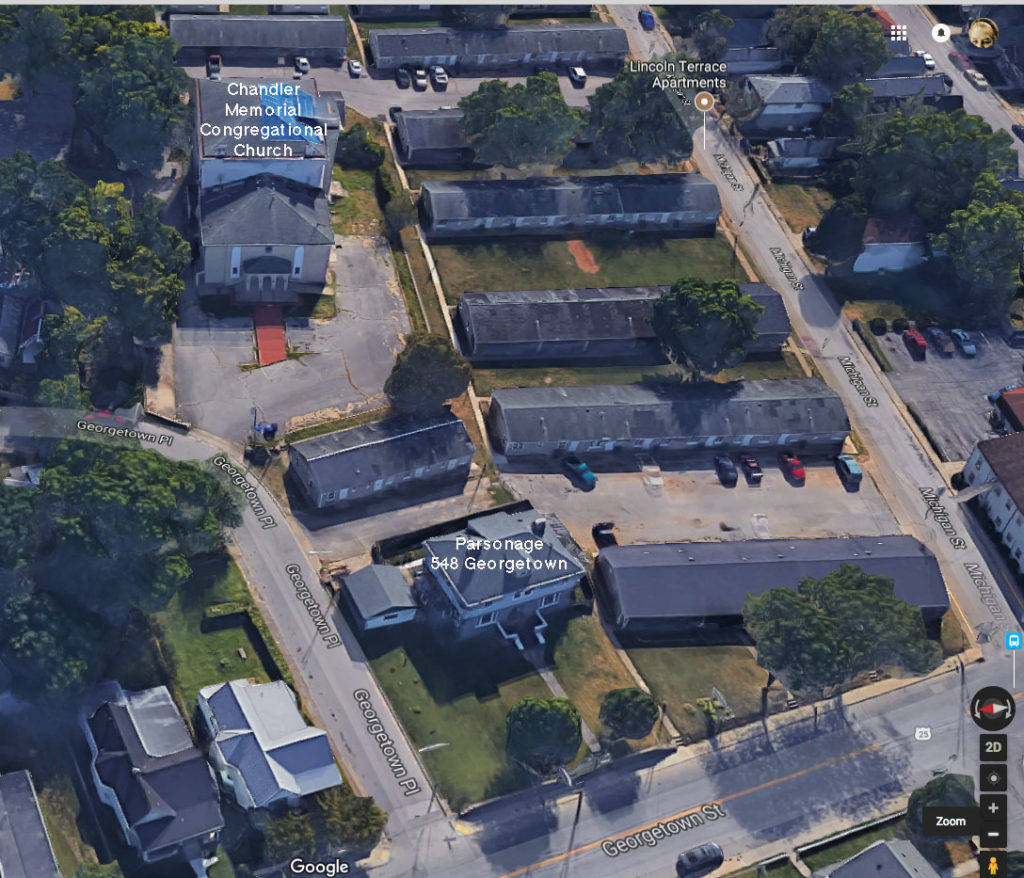

Sunday, Nov 21, 1943
Chandler Memorial church, the Rev. Albert B. Cleage, pastor; worship and sermon 11 a. m., preaching by the pastor. Sunday school, 12:15, Young people’s meeting, 6 p.m. Theme of the morning sermon will be “Fruits of the Spirit.” The annual “harvest home” service will open today. All members and friends are urged to be present. Harvest home sale at 8 o’clock Monday night at the church.
Tuesday, Nov 30, 1943
Regular business meeting will be held Wednesday night at Chandler Congregational church, Rev. Albert B. Cleage Jr., minister.
Sunday, Dec 5, 1943
Chandler Memorial Congregational Church, the Rev. Albert B. Cleage Jr., pastor: worship and sermon 11 a.m., theme, “The Messianic Hope;” music by the choir, Miss Pearl Blackburn, director; vocal solo, Prof. W. J. Black; saxophone solo, Prof. William Smith. Sunday school 12.15; Young People’s meeting, 6 p. m. The pastor is preaching a series of pre-Christmas sermons.
Sunday, December 12, 1943
Chandler Memorial Congregational church, Rev. Albert B. Cleage Jr., minister: worship and sermon 11 a. m., theme, “The Sin of Selfishness.” Sunday school, 12:15; Endeavor, 6 p. m. Important announcement by the trustees. All members asked to be present. The pastor is preaching a series of sermons dealing with the birth of Christ and its meaning or the individual.
Sunday, Dec. 26, 1943
The Chandler Memorial church, 548 Georgetown street, The Rev. Albert B. Cleage Jr. will preach his Christmas sermon from the subject, “Star Of Bethlehem.” The choir will render special Christmas music, and Mrs. Louise Newman will be featured as soloist, Sunday school and Christian Endeavor will meet as usual.
December 12, 1943
January 2, 1944
Chandler Memorial Congregational church, Rev. A. B. Cleage, minister: worship and sermon, 11 a. m., theme, “The Pentecost of Calamity.” Sunday school, 12:15; Endeavor, 6:30 p. m. The church annual meeting will be held Wednesday night at 8 o’clock.
January 7, 1944
January 9, 1944
Chandler Memorial church, Rev. Albert B Cleage, minister; Worship and sermon 11 A. M., theme “Winning the Peace;” Sunday school 12;15; Y. P. meeting at 6:30 p.m. Communion service. Business meeting to elect church treasurer.
January 16, 1944
Chandler Memorial Congregational church, Rev. A. B. Cleage, minister: worship and sermon, 11 a.m., theme, “Bitter Fruit;” Sunday school, 12:15 p. m.; Endeavor 6 p. m.

Saturday, January 29, 1944
The Rev. Albert B. Cleage, who recently resigned as pastor of the Chandler Congregational church, left Wednesday for San Francisco, Calif.

My father was called “Toddy” by family and friends in Detroit and was sometimes called “Toddy” in social items in the Detroit Tribune.
January 29, 1944
Toddy and Doris Cleage are due in from Lexington, KY this week. They have been there since their marriage in November. The young couple found the South’s dyed in the wool policy of segregation and oppression of Negroes most distasteful, and were glad when Toddy received a call to pastor a church in California. So they too will head for the Golden West.
Tribune’s Neighborhood of the Week – 1955
This is a transcription of a feature article that appeared in the black-owned Detroit Tribune, October 29, 1955. The archive of the Tribune can be found on the Library of Congress Web site “Chronicling America.” Follow this link to see the actual article The Detroit Tribune. I have added photographs from my family archive and corrected typos. Please do not reuse without permission and linking to this blog. Thank you.
****
(Editor’s Note: Due to the hugeness of this area, the Tribune is forced to publish this series in two parts. The second part will appear at a later date.)
The Tribune’s “Neighborhood of the Week” is a feature series designed to afford people who generally are not in the news an opportunity for expression and publicity.
This is the sixth area to be covered by the TRIB in Metropolitan Detroit. And by some standards is considered as the “most fabulous.”
Called Gold Coast
Nicknamed as the “Gold Coast,” because of its richly furnished and lavish homes, this new neighborhood was a direct result of the outlawing of restrictive covenants. It literally sprang-up during and after World War II when the city was jammed with defense workers, and was practically bursting at the seams. Old homes are being torn down to make room for the new expressway system and new housing projects. And old Detroiters had to have some place to go.
So, they invaded this area north of West Grand Boulevard and west of Woodward.
Each time the Negro population has to expand, in this and most U.S. cities, there is always the question of where are they going. The problem of dislocation and securing of housing was also true in this case, excepting that integration was prevalent as another problem.
Nevertheless, those who were dislocated, evicted or homeless moved into the “Gold Cost” area from all points over the city. This ingress was so fast that this section is hailed as the fastest developed in modern Detroit history.
What were the consequences of this swift development? As usual, your roving Tribune reporter will take you along with him and find out, visiting the churches, the business places and the “average resident” and let them tell you of their fabulous neighborhood.
Central Congregational
Let’s stop the young and dynamic minister of the Central Congregational Church, the Rev. Albert B. Cleage, Jr.
Since their (the congregation) activities for the day were a fine reflection on the residents of the area, we think their project “Work Day For Christ” should be publicized.
The Junior and Senior Fellowships of the church with the slogan, “Being Christian Means Helping Others.” And they carried out this slogan to the highest as each member contributed a full-day of labor to their world-wide missions on Saturday.
Here is how they were scheduled:
After breakfast at the parsonage at 8 a.m., they worshiped for about 45 minutes before starting to work at odd jobs, such as car washing, holding a bake sale, raking leaves, washing windows and others.

They reported back to the parsonage at 12:30 for a box lunch, then at 1:30 p.m. completed or started on other odd jobs until 5 o’clock when they went for supper, returning at 7 p.m. for a two hour workers party in the parsonage.
Full-Day of Work
This was really a full day for the youths, but they seemed to enjoy it with enthusiasm and eagerness to complete more than two or three jobs during the day.
The Youth Fellowship is geared “to make real demands upon their time, abilities and talents … we accept only those young people who are willing to participate in the total program.
“Young people who are interested only in recreational and social activities can find other organizations and clubs designed to serve their needs.”
Thus, partially reads a somewhat of a preamble for the youth to follow in pushing the church program which has three basic areas of Christian Living, meaning Faith, Action and Fellowship.
More than two hundred young people enrolled in the church’s Junior and Senior Fellowships contributed a day’s labor to raise funds for Congregational Christian World Missions.
A breakfast for the young people was served by a committee of mothers in the recreation room of the spacious church parsonage at 2254 Chicago Blvd.
Mrs. Eleanor Hughes served as chairman and was assisted by Mrs. Julian P. Rogers, Jr., Mrs. Marie Scruggs and Mrs. Barbara Martin.
The breakfast closed with a service of worship and consecration conducted by the Faith Commissions of the two organizations. Participating were Miss Phyllis Hughes, Miss Andree Keneau, James Gilliam, Jr., and Miss Sharon Allen.
The Car-Wash was held at the home of Miss Beverly Baker, 11340 LaSalle Blvd., and parents, church members and residents of the community kept the cars coming from 9 a.m. until 5:30 p.m.

While the car-wash workers, under direction of Curtis Faire, were keeping their production line moving, the Bake-sale and odd- committees were conducting door to door canvasses.
The seemingly inexhaustible supply of baked goods was sold out by two o’clock.
The odd-job brigade raked leaves, took down screens and put up storm windows, scrubbed floors, cleaned basements, washed dishes, and took care of children for busy mothers, and the jobs continued to pour in until the 5:30 quitting time.
On Sunday, members and their parents were invited to a special service of dedication at Central Congregational church, with the pastor, the Rev. Albert B. Cleage, Jr., preaching on “Our Christian World Mission. Afterwards officers of the Fellowship group dedicated the money earned to Christian service.
The Youth Fellowship Choir under direction of Oscar R. Hand and accompanied by Larry Manderville, participated in the service. Miss Gail Payne rendered a solo.
2 1/2 Years Old
Central Church was organized just two and a half years ago by the Rev. Albert B. Cleage, Jr., with services of Worship held in the auditorium of the Crosman School, Hamilton at Clairmont. The church is now engaged in a city-wide Building-Fund drive to make possible the purchase of a church building.
The lack of a building, however, has done little to hamper the development of the church’s outstanding seven-day week program.
The church sponsors a Cub Scout Troop, a Boy Scout Troops, four Girl Scout Troops, two Youth Fellowship organizations, a children’s choir, a youth Choir, and a Boy’s Athletic Club with baseball and basketball teams in the inter-church Recreational League, in addition to a full program of adult activities.

The Men’s Club’s weekly Bowling League and monthly Forum meetings, and the Women’s Cultural Committee Forums, Square Dances, and Bridge Parties are community-wide in scope.
Wayne Graduate
Rev. Mr. Cleage, Jr., is a graduate of Wayne University and the Oberlin Graduate School of Theology. He had completed two years towards his doctorate in religious education at the University of Southern California. Before returning to Detroit, Mr. Cleage held pastorates in Lexington, Ky., the Fellowship in San Francisco, Cal., and the historic old St. John’s Congregational Church of Springfield, Mass.
Before entering the seminary he served as Director of Youth Work at Plymouth Congregational Church at Detroit while employed as a Social Worker. The pastor is active in the Congregational Association of Detroit, of which his church is the youngest of twenty-seven.
Central and Plymouth Congregational churches are the only two designated specifically as Negro in Michigan.
Mr. Cleage serves as Chairman of the Social Action Committee of the Association, and member of its Board of Trustees.
He is on the Camp Management Committee of the Association’s Camp Talahi located near Brighton, Michigan, serving as counselor at both Camp Talahi and the Congregational State Conference Camp, Pilgrim Haven.
Adult Advisor
Mr. Cleage is also one of three adult advisors for the Detroit Association’s Youth Fellowship organizations. He is a regular guest speaker at other Congregational churches. During the past month he has spoken in Eaton Rapids, Dearborn, and Birmingham. He has conducted youth seminars at two churches in Detroit.
At the Fall Religious Education Workshop sponsored by the Detroit Association at the Gross Pointe Congregational Church, Mr. Cleage conducted the Seminar on Youth Work.
Thus, for the moment, we’ll end our visit in the “Gold Coast” area, hoping you will again visit it with us upon our second trip.

Central Congregational Holds First Service in New Edifice
Transcription of an article by Robert L. Crump, which you can find at the bottom of this page and at this link to the Library of Congress “Chronicling America” where the archive of The Detroit Tribune can be found. Detroit Tribune September 28, 1957. I have added photographs from my personal collection and corrected typos. Please do not reuse without permission and linking to this blog.

The day was hesitant, it’s disposition undecided. Sunlight broke though the clouds only to be shut out again. People walked through the streets aimlessly and carefree – but inside the Central Congregational Church there was no aimlessness, no hesitancy or indecision. The congregation was observing its “Home Coming Day,” their first service in a new building.
Those chimes you heard before entering the church were played by brother (Henry). Inside you listened to the moving musical prelude by Mrs. Dorothy Blaylock, organist. George Branham knew. He expressed the sentiments of all when he sang, “Bless This House”.

Then came the formal presentation of the key by David M. Brewster and Jack B. Paul representing Brewster Pilgrim Congregational Church; and accepting for Central was answer to the supplication of James W. Stephens.

As though they knew the “Bless This House,” the choir under the capable direction of Oscar R. Hand did the anthem “Praise To God” beautifully.
As you look to the altar you see a magnificent twenty to twenty five feet stained glass window. It is truly a masterpiece. The coloring is so tremendous that even when the sun isn’t shining on it, it still maintains vivid color life.
To the right of this window on the rostrum, Saturday Dr. Edward W. Wilcox for the congregational association on the left sat a man, who’s “dream” is now, reality, after four and one half years.
Now it was his turn to say “thank you” to those who had placed their shoulders to the wheel both physically and financially. I, and not I alone, watched him as he walked to the pulpit, he stood for a second and braced himself against the object that has for centuries been the symbol of self dedication.
Instead of the Ram that was tied in the thicket as in the biblical story of Abraham and Isaac he was offering himself as a living sacrifice, and dedicating.

He mentioned the names of four people who have passed, Mrs. Willie Strauther, Mrs. Mabel Clarry, Mrs. Eleanor Hughes and his beloved father. Albert Cleage, Sr. The timber of his voice changed at the mention of his dad. I realize it was extremely difficult to hold back the tears. His mother, Mrs. Cleage Sr. in an effort to help, turned her head and her eyes from him, two sisters in the choir hoped almost in available tones he would not break another sister and three brothers in the congregation did the same, and in a split second the power of combined prayer was manifested.
He spoke of the great friendship that still exists between Plymouth Congregational Church and Central; also the debt of gratitude that cannot be paid to the Rev. Horace A. White of Plymouth for his encouragement and advice during Central’s trying times.
He talked of the church’s position in the community, of the Ministers role in the church some of the development of a Christ like community’ like being able to look your worst enemy in the face and honestly see good in him. Then, “This Man” mentioned Nashville, and Little Rock and the disturbance that was taking place.
He spoke of Faubus and Ike and as he did my thoughts sort of wandered to three words, “Faith, Hope and Charity.” and another line, “But the Greatest of these is “Love”. Then with Rare Richness and tonal beauty Melvin Thompson sang, “I talked to God last night.”
While he sat listening to the solo and looking over the filled auditorium I know he believed in the inscription on the alter, “Love Never Faileth.”.
I had the pleasure of again shaking the hand of a man who’s dream was now a reality: The Rev. Albert B. Cleage, Jr. minister of the Central Congregational Church 7625 Linwood Ave. at Hogarth.
Cousins Christened – 1948
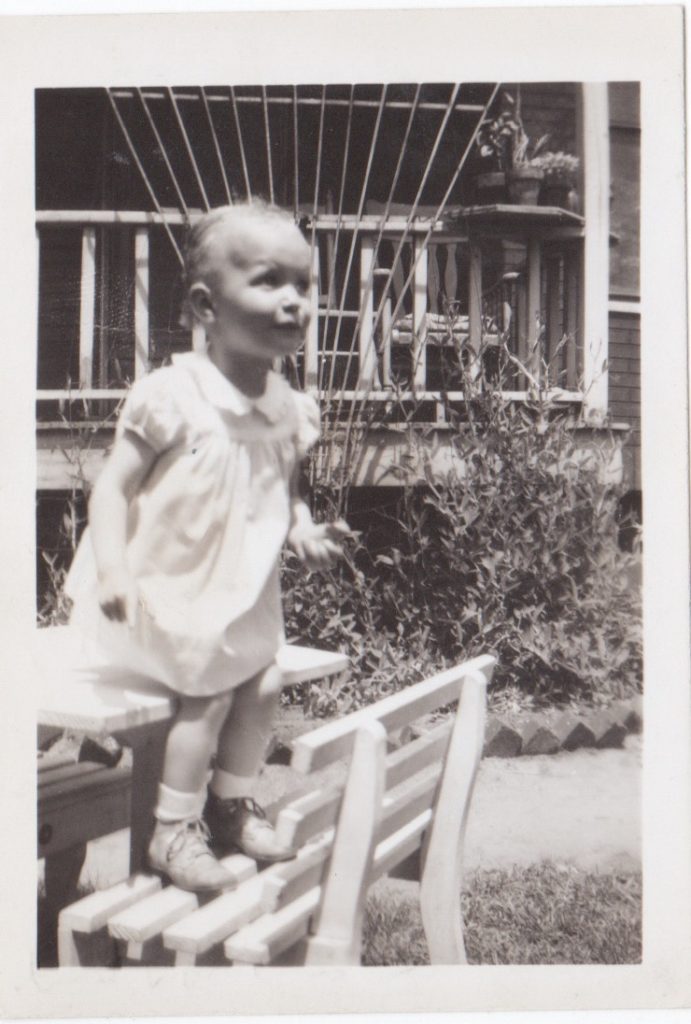

They should have given the names of the children!
“Reverend and Mrs. Albert Cleage (Toddy and Doris) and their little daughter are back home again in Springfield, Mass after a three week sojourn here with their parents Dr. and Mrs. Albert and Mr. and Mrs. M.C. Graham. During their stay in Detroit, a triple christening took place at Plymouth Congregational church when their 22 month old daughter was christened, along with the five months old daughter of Mr. and Mrs. Frank Elkins, and the two children of Mr. and Mrs Henry Roberts All four children are cousins.”
I never knew that my cousin Barbara Elkins and two of her cousins were baptized on the same day that I was until I was going through the archives of the Detroit Tribune recently. It was published by my grandmother Fannie’s first cousin, James McCall and there were lots of little family mentions that were never mentioned in the white papers of the day.
We should have known that. As my sister Pearl said, it gave us a special bond, Baptism Sisters. Barbara and I did have a special bond. I didn’t see the other girls enough to develop a bond. They were Barbara’s cousins on her father’s side while we were cousins on our mother’s side.


